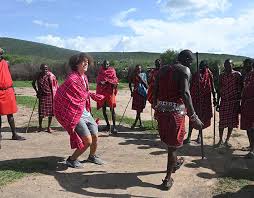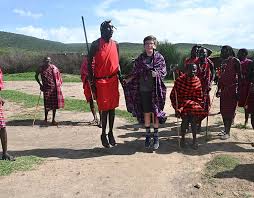
Maasai clothing is known for its distinctive and eye-catching features. Some of the key elements of Maasai clothing include:
1. Shuka or Shúkà: The shuka is a traditional Maasai blanket worn by both men and women. It is typically made from red or blue plaid fabric, often with stripes or patterns. The shuka is draped over the shoulders, with one end typically thrown over one shoulder.

2. Beadwork: Beadwork is an integral part of Maasai culture and is prominently featured in their clothing. Beads are intricately woven onto clothing, such as collars, belts, and headdresses, creating vibrant patterns and designs. The colors and patterns of the beads have symbolic meanings in Maasai culture.
3. Warrior Shields and Spears: Maasai warriors often incorporate shields and spears into their attire. These shields, made from animal hides and decorated with intricate designs, are held by warriors during important ceremonies and gatherings.
4. Kangas and Kikois: Kangas and kikois are pieces of fabric that the Maasai use for various purposes, including clothing. Kangas are rectangular pieces of fabric worn by women as skirts or wrapped around the body as a dress. Kikois are similar, but worn by men as wraps or sarongs.
5. Head Ornaments: Maasai often adorn their heads with various accessories, including colorful beads, feathers, and cowrie shells. This includes the well-known red ochre-dyed hairstyles, often styled into intricate braids and adorned with beads.

6. Sandals: Maasai sandals, known as enekos or akalas, are made from recycled car tires and are an essential part of Maasai footwear. The sandals feature intricate beadwork patterns, making them unique and visually striking.
These key elements of Maasai clothing combine to create a vibrant and culturally rich visual identity that is recognized and celebrated around the world.


